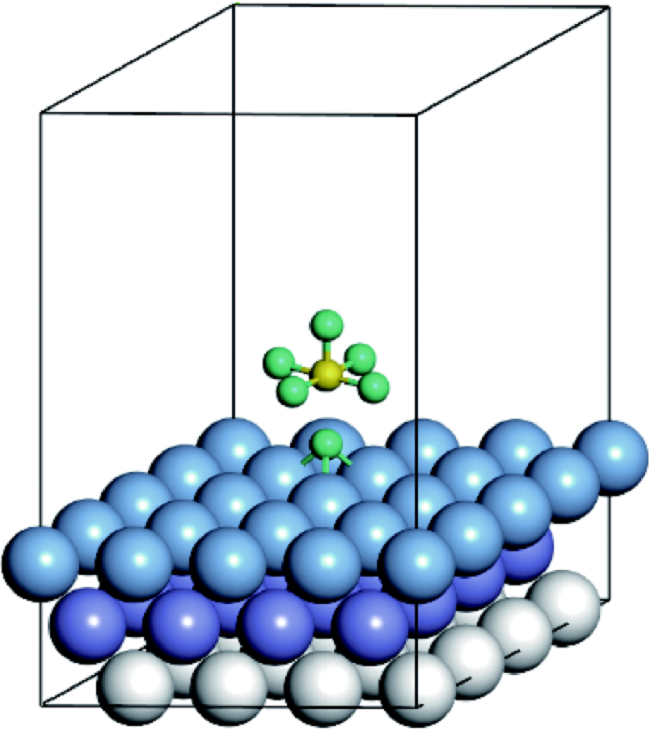
图1 SF6在Ag(111)表面的初级裂解
摘要 运行经验显示SF6在气体绝缘开关设备(GIS)中的热稳定性低于预期,GIS内部的金属表面可能对SF6初级分解与次级反应具有显著的影响作用,但作用机理尚不明晰。该文基于密度泛函理论获得了O2在Ag表面的解离-吸附构型,并建立了低氟硫化物与Ag表面O原子的反应模型,初步揭示了GIS过热故障状态下SF6初级分解产物在Ag表面的氧化反应机理;基于过渡态理论和反应动力学理论,计算获取了界面反应的能垒和反应速率常数,并与气相反应对比,分别确定了三种低氟硫化物的氧化反应路径及其主要场所,并分析了Ag表面对反应的促进/抑制作用机制。结果显示,Ag表面可显著促进SOF4与SOF3的产生,但不利于SF2的表面氧化反应。
关键词:气体绝缘开关设备 六氟化硫 过热分解 银表面 氧化反应
气体绝缘开关设备(Gas Insulated Switchgear, GIS)因具有可靠性高、维护工作量少、占地面积小的优点而广泛应用于现代电力系统[1]。但是GIS的全封闭结构也导致其内部的初期故障难以诊断[2]。由于机械工艺和安装不规范,以及长期运行后弹簧松动和接头接触不良等原因[3],GIS气室内部可能出现局部过热故障(Partial Over-thermal Fault, POF)[4],导致SF6气体发生分解。首先,SF6在高温作用下发生自身的初级分解,生成SF5、SF4、SF3、SF2等低氟硫化物[5]。这些低氟硫化物可能进一步与微量的水分、氧气等杂质发生次级反应,生成SO2、SOF4、SOF3、SOF2、SO2F2、S2F10O等硫氧化物,以及H2S、HF等含氢副产物[6]。这一现象说明SF6气体在实际设备故障状态下存在显著的分解,其化学稳定性低于预期[7],而其稳定失效的机理需要进一步研究。
在分解产物中,SOF2、SO2F2等含氧产物是重要的特征产物,可用于辅助诊断GIS内部的故障状态[8]。这些重要产物部分来自低氟硫化物的氧化反应。若无O2等氧化剂的存在,SF6即使在放电或热故障下发生初步解离,产生的低氟硫化物,如SF5,仍可以在故障后或非故障区域与F原子重新复合而使设备恢复原本的绝缘性能[9]。但是由于不可避免的杂质残留和气体泄漏,气室内仍存在O2与低氟硫化物发生反应,并生成上述硫氧化物。
目前,SF6过热分解的宏观特性已有相当多的研究。C. T. Dervos等通过实验研究了金属作用下SF6的热稳定性以及反应后金属表面的形态变化[10]。曾福平等设计并建立了过热故障模拟实验平台,研究了SF6在300~400℃范围内的分解[11],以及微量水分的影响特性[12]。丁卫东等开展过热故障模拟实验,研究了固体绝缘材料对SF6高温分解产物的影响规律[13]。
在微观层面,已有一些学者基于密度泛函理论(Density Functional Theory, DFT)研究了SF6在气相空间中的分解反应过程。付钰伟等研究了生成SOF2、SO2F2和SO2F的反应路径能量[14];钟理鹏等计算了低氟硫化物SF5、SF4、SF3等分子与OH自由基或活性O原子之间的反应能垒[15];曾福平等基于过渡态理论,研究了O2与低氟硫化物的气相反应[16]。但是,以上理论层面的计算还不能描述SF6故障分解的真实微观过程。首先,未说明O2分子如何裂解并提供O原子,而这一过程本身就需要较高的能量[17];其次,SF6分解反应计算得到的反应能垒普遍较高,与实际设备运行状态不匹配;最后,GIS本身作为金属全封闭结构,内部存在Cu、Al、Ag等金属[18],其作用机理未被考虑,尚需深入研究。GIS内部触头、电连接等位置常使用镀银工艺进行保护[19],而触头、导杆连接处工作温度较高,是局部过热故障的主要发生位置,在故障下Ag表面直接与SF6气体及其他杂质气体接触,该作用机理亟待研究。
近期研究发现:Ag金属表面对SF6及其分解产物SO2具有明显的吸附作用[20],为进一步研究Ag表面发生的化学反应奠定了基础。国外学者还通过计算指出,O2在Ag(111)表面发生解离吸附的反应能垒远低于气相分子直接裂解的反应能垒[21]。因此,在Ag表面的吸附作用下,SF6以及设备气室内残留的O2更容易在Ag金属的接触表面发生分解并产生低氟硫化物和吸附的O原子等。与O原子进一步相互作用后,SF6初步分解产生的低氟硫化物可能被氧化并生成如SOF2、SOF3、SOF4等含氧物质。而目前尚缺乏对于低氟硫化物在Ag表面经氧化反应生成重要硫氧化物的机理研究。因此,本文将重点开展以下方面的研究:①基于O2在Ag金属表面的解离吸附构型,构建气-固作用界面;②探究低氟硫化物在Ag表面的氧化反应过程,寻找反应过渡态,分析主要含氧产物的生成条件;③计算反应路径的能量变化,进行动力学分析,计算反应速率常数等关键参数;④与气相反应对比,分析Ag表面对各反应路径的影响作用。
首先,需根据O2和SF6以及低氟硫化物在Ag表面的吸附方式,建立合理的反应路径假设。对于O2,没有金属的催化作用时具有较强的化学稳定性,其O=O的键能为494 kJ/mol(约为118.07 kcal/mol)[17]。根据O=O键能与反应速率的关系,在400℃的温度下O2应仍能维持稳定,无法解离生成大量O原子。但是在Ag表面,研究发现O2容易发生吸附解离,解离产生的O原子易吸附于Ag(111)表面的面心立方(face-centered cubic, fcc)位点,而该吸附解离过程仅需克服约28.59 kcal/mol的能垒[21]。这可能是GIS设备故障时SF6气体能分解并与氧气反应而生成硫氧化物的重要原因。
前期研究[20]发现:SF6在Ag表面可通过化学吸附,F原子与表面Ag原子成键并脱离SF6分子,导致解离。解离吸附后会在靠近Ag表面的位置生成较多的低氟硫化物SFx(x=5, 4, 3, 2),容易发生进一步的裂解或界面反应,如图1所示。若Ag表面含有吸附解离的O2,可能在界面上发生化学反应而生成硫氧化物,而且局部过热故障可能对界面反应十分有利:①体系能量升高,将有利于反应体系跨越反应能垒;②高温将加速界面反应的速率;③一般解吸附为吸热过程,而高温将显著促进低氟硫化物界面反应后的生成物快速脱离Ag表面,从而促进反应持续向正反应方向进行。

图1 SF6在Ag(111)表面的初级裂解
绿色小球—F原子 黄色小球—S原子 蓝色圆球—第一层Ag 原子 紫色圆球—第二层Ag原子 白色圆球—第三层原子
Fig.1 Primary cleavage of SF6 on the surface of Ag(111)
基于上述分析,低氟硫化物与表面的O原子/O2的反应过程属于界面反应中常见的一种,称为Eley-Rideal机理,该反应示意图如图2所示。一种反应物(气体分子A)首先吸附于表面,形成一种类似配合物的结构;然后另一反应物(气体分子B)掠过该表面,并与气体分子A发生反应;最后反应产物从表面获取能量脱附至气相空间中。如前文所述,本文主要关注SOF4、SOF3、SOF2三种重要的含氧产物的生成过程。已有研究表明,在SO2的生成过程中,O2的参与程度较低[22],且SF6发生完全解离并生成S原子的难度极大,因此本文未探讨SO2的生成过程。图2中,B分子代表SF4、SF3和SF2三种氟硫化物。

图2 Eley-Rideal机理示意图
Fig.2 Schematic diagram of the Eley-Rideal mechanism
首先,构建厚度为3层的Ag金属薄板,晶胞范围为4×4,在表面上方添加厚度为15 Å(1 Å=10-10 m)的真空层,该薄板的厚度可以同时兼顾准确性和计算效率[23]。如图1所示,不同层数的Ag原子以不同的颜色区分。计算过程中,将底部两层原子固定;顶层原子处于弛豫状态,以模拟表层金属原子与气体分子之间的直接作用。
气-固接触界面的存在可能通过吸附作用显著地降低气体分子裂解的难度[24]。SF6分子在Ag金属表面发生化学吸附后[20],可能裂解并生成SF5、SF4等硫氟化物和F原子,脱去的F原子倾向于吸附到Ag(111)表面的面心立方(fcc)位点并与表层Ag原子成键;低氟硫化物停留在F原子上方,可能进一步发生吸附或表面反应。图3标注了Ag(111)表面的顶位(top)、面心立方和密排六方(hexagonal closepacked structure, hcp)吸附位点。

图3 Ag(111)表面吸附位点示意图
Fig.3 The adsorption sites on the surface of Ag(111)
本文的电子结构优化计算是基于DFT,使用Dmol3模块[25]计算获得的。选择GGA(generalized gradient approximation)-PBE(Perdew Burke Ernzerhof)泛函[26-27],该泛函适合用于涉及金属的体系,基组选择双数值正极化(Double Numerical plus Polarization, DNP)[28],具有较高的计算精度。使用Grimme方法对所选泛函进行色散校正[29]。自洽场(Self-Consistent Field, SCF)收敛阈值(tolerance)设置为1.0×10-5,原子截断半径设置为6.0 Å。
使用微动弹性带(Nudged Elastic Band, NEB)方法确定目标反应的最低能量路径,寻找反应的过渡态(Transition State, TS)结构。对搜索到的过渡态进行频率分析,获得TS的热力学性质,包括焓H、熵S、自由能G以及反应过程中的变化量。然后分别计算在气相空间中和Ag表面的反应速率常数。气相反应的过渡态搜索在文献[16]中已见报道,计算方法和过程不再赘述。对于界面反应,其速率常数可以使用Arrhenius公式表示,即
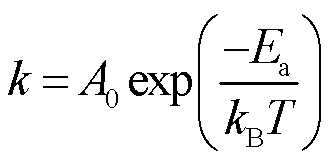 (1)
(1)
式中,k为反应速率常数;A0为指前因子;Ea为通过DFT计算获得的对应反应的活化能;kB为玻耳兹曼常数;T为温度。对于界面反应,A0可通过式(2)计算获得[30]。
 (2)
(2)
式中,ΔS为熵变,具体为过渡态相对于初始态(Initial State, IS)的熵增,即ΔS=STS-SIS;h为普朗克常数。最后,对比分析气相反应与界面反应,分析Ag(111)表面对反应的影响。
已有研究表明,O2分子较容易吸附于Ag金属表面,且在吸附过程中解离为O原子并在表面扩散。O原子的稳定吸附位点以fcc位点为主[21]。本文主要研究了吸附的O原子与靠近表面的低氟硫化物分子的反应。
通过几何优化计算,获得O原子在Ag表面fcc位点的吸附构型,如图4所示。O原子与fcc空位附近的Ag原子形成化学键,此时O原子距离表层Ag表面约为1.481 Å。
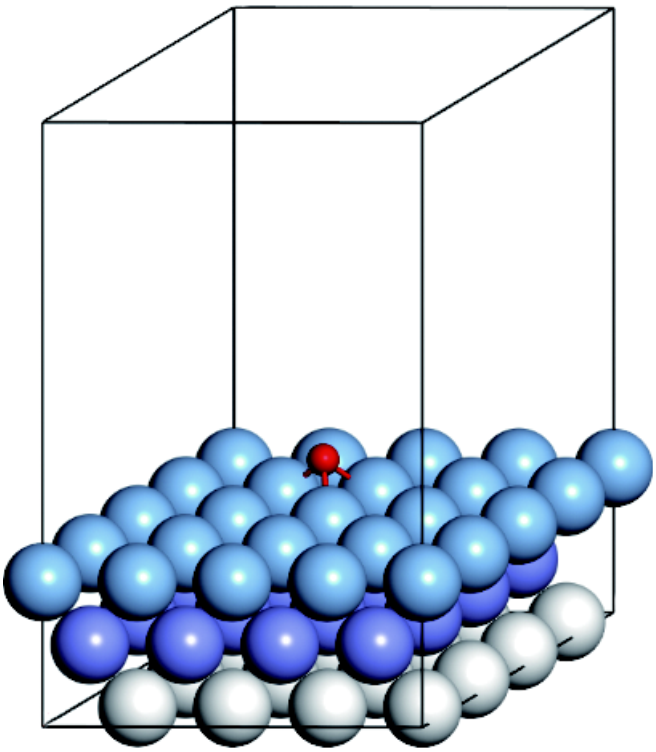
图4 Ag(111)表面O原子的吸附构型
Fig.4 Adsorption configuration of the O atom on the Ag(111) surface
考虑到本文研究内容针对的是设备气室内少量的氧气[31],因此表面O原子覆盖度较低,主要研究低氟硫化物与吸附的O原子之间的反应过程,临近的表面位点不放置其他O原子。
2.2.1 SF4与吸附氧原子的反应
SF4可能与Ag(111)表面的O原子结合生成SOF4,如式(3)所示,反应过程如图5所示。根据反应路径,可分别建立反应物和产物的模型,如图5a和图5c所示。
式中,gas表示气态分子;ads表示吸附态原子。

图5 SF4与O原子结合生成SOF4的过程
Fig.5 Combination of SF4 and the O atom to form SOF4
首先,分别进行几何优化,获得SF4、SOF4等分子的优化构型和分子能量;然后,构建反应物模型:将SF4分子放置在距离吸附O原子3.50 Å的正上方,该距离可以模拟物质之间相互作用,但未形成新的化学键的临界状态;产物的构型是完成反应后的SOF4分子,放置于表面上方,距离表层Ag原子表面3.00 Å。
对已建立的反应物-产物反应路径,进行路径过渡态搜索计算。反应的过渡态结构如图5b所示。可以看到,O原子已初步脱离Ag表面,并与S原子形成双键,S原子与O原子之间的距离为2.03 Å,大于产物的双键长度(1.45 Å)。最终,O原子进一步靠近SF4分子,生成SOF4分子并进一步远离Ag(111)表面。
根据反应物、过渡态、产物的计算结果,获得了SF4与吸附氧原子在Ag(111)表面反应生成SOF4的能垒,并与SF4与氧气分子在自由空间中的反应作对比,如图6所示。在Ag(111)表面,反应能垒为16.284 kcal/mol。然而,在气相空间中SF4与O2反应生成SOF4需要跨越57.032 kcal/mol的反应能垒。相比而言,在Ag(111)金属表面,生成SOF4的难度(所需活化能)降低了71.45%,从而导致SOF4的生成速率显著提升,这一点可以通过动力学分析直观、量化地体现。
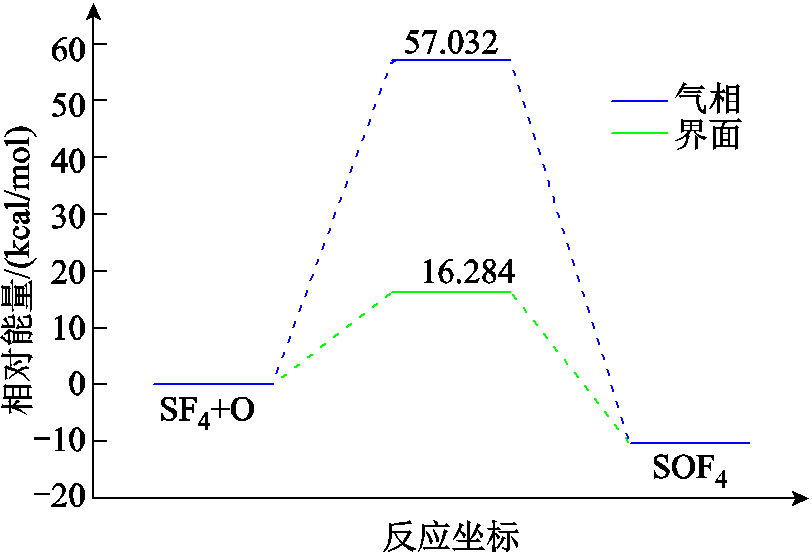
图6 SF4与表面O反应过程的相对能量变化
Fig.6 Relative energy change during the reaction of SF4 with the surface O atom
一般而言,典型局部过热故障的温度范围在300~660℃,这是因为SF6气体在300℃左右开始分解并产生少量的气体分解产物[11],而当局部热点超过660℃时,会导致铝的熔化,引起电弧击穿等严重故障。本文根据式(1)和式(2)计算了在Ag(111)表面反应式(3)的指前因子,以及常温(298.15 K)和典型局部过热温度(673.15 K)下的反应速率常数,并与气相反应速率常数对比,结果见表1。
表1 气相和界面反应生成SOF4的速率常数对比
Tab.1 Comparison of rate constants for gas phase and interfacial reactions to form SOF4

场所A0/s-1k298.15K/s-1k673.15K/s-1 界面7.37×1098.54×10-33.81×104 气相1.18×1071.86×10-351.69×10-7
通过对比可以看出,Ag表面对反应式(3)具有显著的催化作用。在常温下,无论是在界面还是气相,该反应都难以快速进行。尤其是在气相反应条件下,反应速率常数低至10-35量级,即基本不发生反应。在过热故障温度T=673.15 K时,两种反应的速率常数都有所升高。为了与真实化学反应进程相联系,可进一步根据速率常数与反应速率的关系,推算反应半衰期,即反应物消耗一半所需的时间。对于一级反应,反应速率与速率常数、物质浓度的关系为
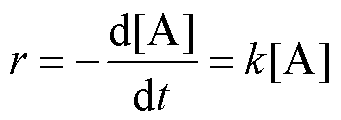 (4)
(4)
式中,[A]为A物质的浓度。由式(4)可以推导出半衰期的计算公式,可得
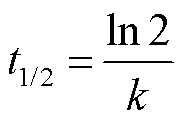 (5)
(5)
根据式(5),计算得到在两个温度下界面反应和气相反应的半衰期,见表2。
表2 气相和界面反应生成SOF4的半衰期对比
Tab.2 Comparison of half-lives for gas phase and interfacial reactions to form SOF4

场所半衰期/h 298.15 K673.15 K 界面2.26×10-25.05×10-9 气相1.04×10311.14×103
在气相空间中,反应式(3)正反应方向进行的速率极为缓慢,常温下该反应可视为不发生,400℃的高温下需要超过1 140 h才能完成一半的进度。而在Ag表面的催化作用下,即使在常温下,反应仅需0.022 6 h(81.16 s)即可进行至一半;在400℃时反应速率极快,半衰期低至5.05×10-9 h。由此可见,Ag表面的存在可以使得原本在常见过热故障的温度范围内速率极缓慢的气相双分子反应在界面上发生,且在高温下反应速率极快。该结果同时也说明在GIS过热故障状态下,SOF4可以由SF4与O2作用生成,而并非仅来自于SF5等物质与H2O的反应[11,32]。
2.2.2 SF3与吸附氧原子的反应
SOF3也是SF6分解的产物之一,但是该物质化学性质不稳定,难以检测,且容易分解生成SOF2和F原子。其生成过程为
 (6)
(6)
构建反应模型并进行过渡态搜索,反应的过程如图7所示。对反应物、过渡态、产物分别进行能量计算,获得反应式(6)的相对能量变化如图8所示。在Ag(111)表面,反应式(6)的能垒为8.062 kcal/mol。根据式(1)和式(5)计算反应速率常数和半衰期,并与气相反应相对比,分别见表3和表4。结果显示:因为Ag表面显著降低了生成SOF3所需的反应活化能,所以在SF6-Ag气固接触界面的反应速率远高于气相空间的反应速率。在常温下反应式(6)已能在Ag金属表面快速进行,反应半衰期低至2.61×10-9 h;而同样的温度下对应的气相反应速率极缓慢。随着温度升高,气相反应速率显著提高,在400℃下反应半衰期已低至10-6量级。据此分析,整体上Ag金属界面始终是SOF3生成反应的主要场所,但随着温度升高,气相反应对SOF3的生成也起到了一定的作用。
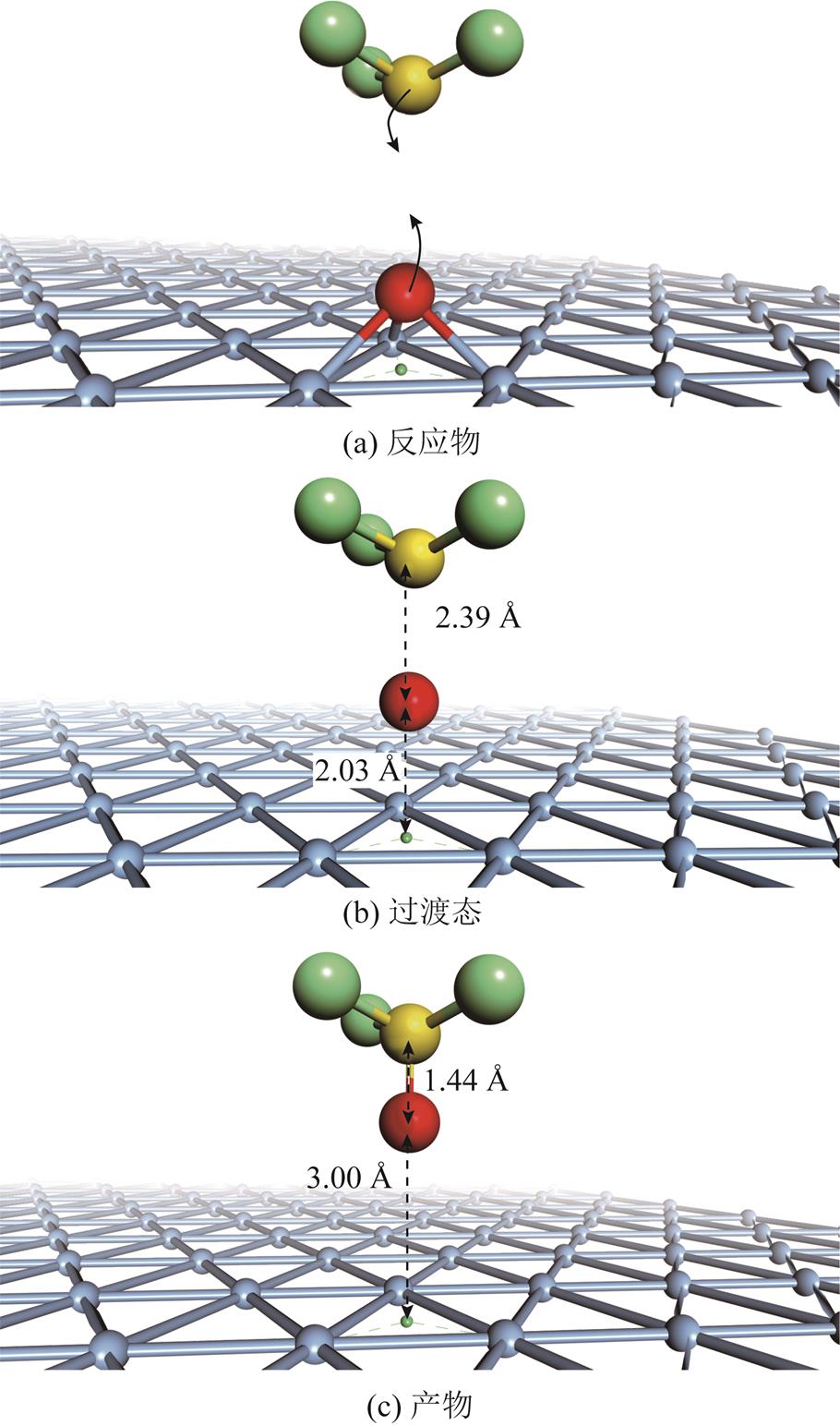
图7 SF3与O原子结合生成SOF3的过程
Fig.7 Combination of SF3 with the O atom to form SOF3
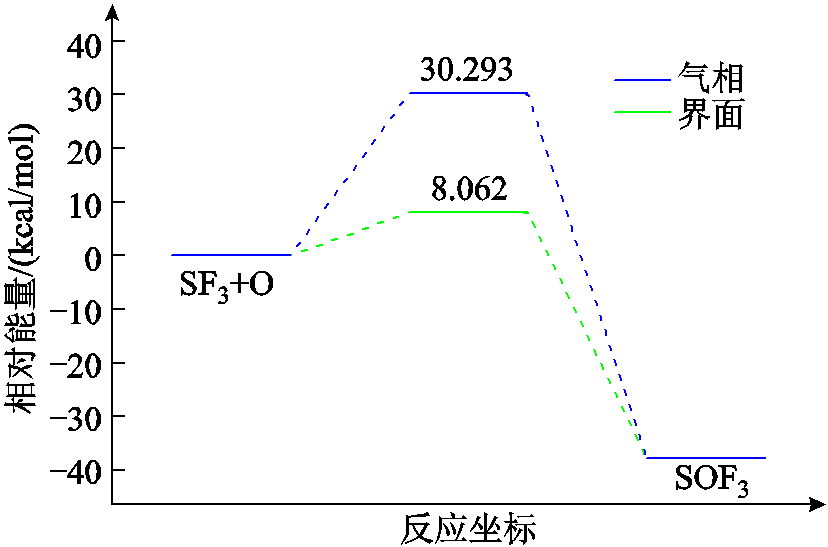
图8 SF3与表面O反应过程的相对能量变化
Fig.8 Relative energy change during the reaction of SF3 with the surface O atom
表3 气相和界面反应生成SOF3的速率常数对比
Tab.3 Comparison of rate constants for gas phase and interfacial reactions to form SOF3

场所A0/s-1k298.15K/s-1k673.15K/s-1 界面5.98×10107.37×1041.44×108 气相1.18×1073.55×10-165.86×101
表4 气相和界面反应生成SOF3的半衰期对比
Tab.4 Comparison of half-lives for gas phase and interfacial reactions to form SOF3

场所半衰期/h 298.15 K673.15 K 界面2.61×10-91.33×10-12 气相5.42×10113.28×10-6
2.2.3 SF2与吸附氧原子的反应
SF2与氧气的反应过程对于掌握SF6的故障分解机理和设备故障诊断具有重要意义[33-34]。在氧气氛围中,SOF2主要来自于SF2与O2的直接反应。在Ag金属表面,反应主要通过SF2与吸附的O单原子结合,反应式为
 (7)
(7)
该界面反应的结构变化及能量变化分别如图9和图10所示。与SOF4、SOF3的生成过程类似,SF2分子靠近Ag表面的O原子,并向彼此靠近。过渡态结构是S与O原子之间距离达到2.44 Å,接近成键,随后距离进一步缩短,形成稳定的S=O键,键长约为1.44 Å。此外,在反应过程中,F—S—F夹角也在不断减小,从最初的99.98°减小至产物的92.56°。该反应在Ag(111)表面所需活化能为27.540 kcal/mol,而在气相空间中SF2气体与O2反应生成SOF2气体的活化能仅为12.575 kcal/mol。
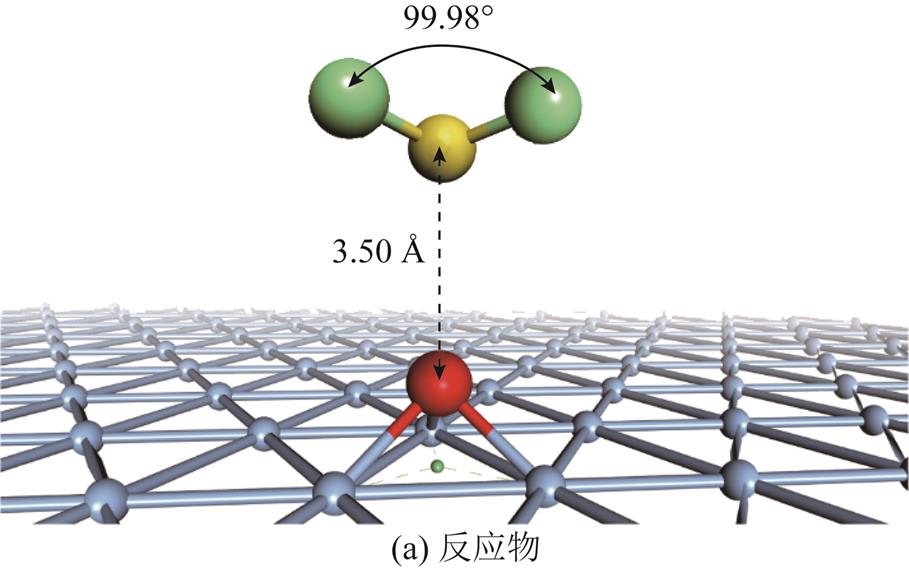
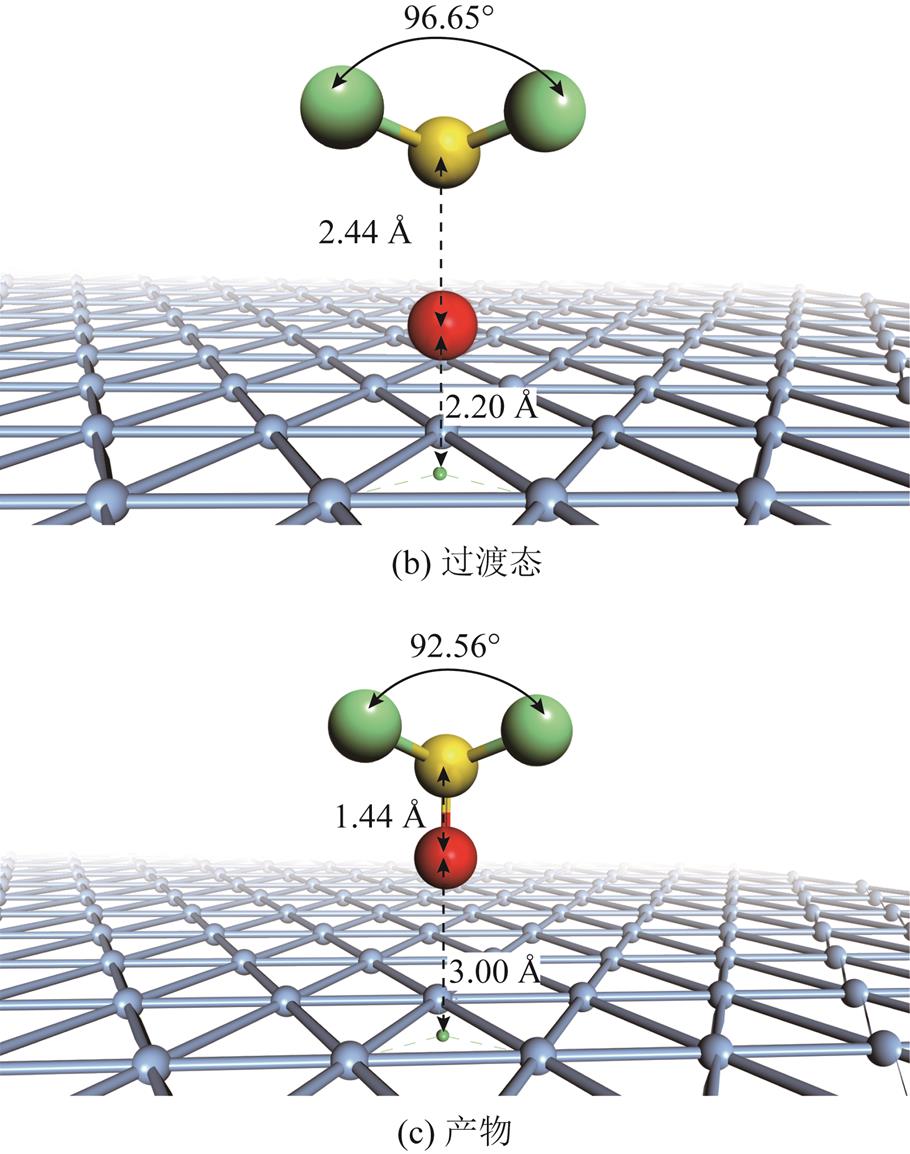
图9 SF2与O原子结合生成SOF2的过程
Fig.9 Combination of SF2 with the O atom to form SOF2
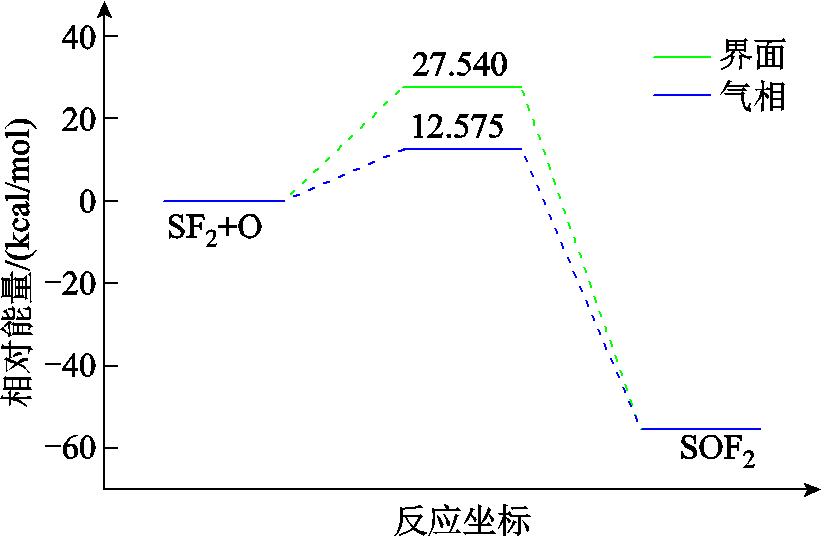
图10 SF2与表面O反应的相对能量变化
Fig.10 Relative energy change during the reaction of SF2 with the surface O atom
与SOF4、SOF3的生成反应不同,Ag表面并未降低SOF2生成反应的活化能,反而提高了反应能垒,导致界面反应速率远低于气相空间。
表5列出了生成SOF2的界面反应和气相反应的速率常数对比。由于体系的熵增ΔS较大,在Ag表面发生的界面反应具有远高于气相反应的指前因子A0,但是其能垒比气相反应高出了119.0%,使得速率常数始终远低于气相反应。分析其根本原因,可能是因为相比于SF4和SF3,SF2体积、质量更小,在Ag表面的吸附作用下,难以与O原子共同脱离表面并形成SOF2气体分子。因此,Ag表面对于SOF2的生成起到了抑制作用。可以得出结论:无论是在常温还是典型过热故障温度下,SOF2的主要产生场所均为气相空间,而非Ag金属表面。
表5 气相和界面反应生成SOF2的速率常数对比
Tab.5 Comparison of rate constants for gas phase and interfacial reactions to form SOF3

场所A0/s-1k298.15K/s-1k673.15K/s-1 界面8.00×1095.21×10-119.16 气相2.051.29×10-22.52×108
为了研究GIS设备内部SF6分解产物生成过程中Ag金属表面的作用及机理,本文在前人研究的基础上,建立了低氟硫化物SFx与Ag(111)表面O原子的界面反应模型,并从反应动力学的角度比较、分析了Ag金属对反应的影响,得到以下结论:
1)Ag界面的存在使得原本在气相空间常温和过热状态下都难以发生的SOF4生成反应能够在常温下进行,且其反应速率随着温度升高进一步提升,可瞬间完成,400℃时半衰期低至5.05×10-9 h。与气相反应相比,该反应的能垒在Ag表面的催化作用下降低了71.45%。
2)Ag表面还显著降低了生成SOF3所需的活化能,使其在常温下可以快速生成;生成SOF3的气相反应对温度较为敏感,使其在过热状态下具有较快的反应速度,因此Ag表面和气相空间都是SOF3生成的重要反应场所。
3)与SOF4、SOF3不同,Ag表面未能促进SOF2的生成反应,反而会提高反应的能垒,显著降低反应速率常数。据此判断,SOF2主要通过SF2与O2在气相空间直接反应生成。主要原因可能是SF2分子质量较小,Ag表面对其吸附作用较强,导致SF2与表面O原子作用后难以脱离表面,抑制了SOF2气体分子的生成。
本文的研究结果揭示了GIS故障状态下至关重要的低氟硫化物及氧气-银表面的气-固反应机理,发现了Ag对于其中若干反应的高效催化作用,从而解释了先前人们对SF6稳定性失效原因的疑问。本文所建立的研究方法有望对气-固反应研究起到一定的启发作用。
参考文献
[1] 刘鹏, 吴泽华, 朱思佳, 等. 缺陷对交流1100kV GIL三支柱绝缘子电场分布影响的仿真[J]. 电工技术学报, 2022, 37(2): 469-478. Liu Peng, Wu Zehua, Zhu Sijia, et al. Simulation on electric field distribution of 1100kV AC tri-post insulator influenced by defects[J]. Transactions of China Electrotechnical Society, 2022, 37(2): 469-478.
[2] 李彦飞, 汤贝贝, 韩冬, 等. SF6放电的发射光谱特性分析与放电识别[J]. 电工技术学报, 2022, 37(7): 1866-1874. Li Yanfei, Tang Beibei, Han Dong, et al. Spectroscopy analysis of emission spectrum characteristics and discharge recognition of SF6 gas discharge[J]. Transactions of China Electrotechnical Society, 2022, 37(7): 1866-1874.
[3] 李洪涛, 舒乃秋, 孙国霞, 等. 气体绝缘开关设备母线接头过热失效的相似模型[J]. 中国电机工程学报, 2014, 34(24): 4137-4144. Li Hongtao, Shu Naiqiu, Sun Guoxia, et al. Scale model of overheat failure in gas-insulated switchgear bus contact[J]. Proceedings of the CSEE, 2014, 34(24): 4137-4144.
[4] 纽春萍, 矫璐璐, 王小华, 等. 基于多场耦合的环保型GIS热特性分析[J]. 电工技术学报, 2020, 35(17): 3765-3772. Niu Chunping, Jiao Lulu, Wang Xiaohua, et al. Thermal characteristics analysis of environmentally friendly GIS based on multi-field coupling[J]. Transactions of China Electrotechnical Society, 2020, 35(17): 3765-3772.
[5] van Brunt R J, Herron J T. Plasma chemical model for decomposition of SF6 in a negative glow corona discharge[J]. Physica Scripta, 1994, 1994: 9-29.
[6] 张施令, 姚强, 李新田. 基于法兰式光纤传感技术的高压组合电器HF气体在线检测[J]. 高电压技术, 2019, 45(2): 402-409. Zhang Shiling, Yao Qiang, Li Xintian. On-line monitoring of HF gas in high voltage GIS based on flange optical fiber sensing technology[J]. High Voltage Engineering, 2019, 45(2): 402-409.
[7] Chu F Y. SF6 decomposition in gas-insulated equipment[J]. IEEE Transactions on Electrical Insulation, 1986, EI-21(5): 693-725.
[8] 唐炬, 杨东, 曾福平, 等. 基于分解组分分析的SF6设备绝缘故障诊断方法与技术的研究现状[J]. 电工技术学报, 2016, 31(20): 41-54. Tang Ju, Yang Dong, Zeng Fuping, et al. Research status of SF6 insulation equipment fault diagnosis method and technology based on decomposed components analysis[J]. Transactions of China Electrotechnical Society, 2016, 31(20): 41-54.
[9] Herron J T. Thermochemical data on gas phase compounds of sulfur, fluorine, oxygen, and hydrogen related to pyrolysis and oxidation of sulfur hexafluoride[J]. Journal of Physical and Chemical Reference Data, 1987, 16(1): 1-6.
[10] Dervos C T, Vassiliou P, Mergos J A. Thermal stability of SF6 associated with metallic conductors incorporated in gas insulated switchgear power substations[J]. Journal of Physics D: Applied Physics, 2007, 40(22): 6942-6952.
[11] Zeng Fuping, Tang Ju, Fan Qingtao, et al. Decomposition characteristics of SF6 under thermal fault for temperatures below 400℃[J]. IEEE Transactions on Dielectrics and Electrical Insulation, 2014, 21(3): 995-1004.
[12] 唐炬, 潘建宇, 姚强, 等. SF6在故障温度为300~400℃时的分解特性研究[J]. 中国电机工程学报, 2013, 33(31): 25, 202-210. Tang Ju, Pan Jianyu, Yao Qiang, et al. Decomposition characteristic study of SF6 with fault temperature between 300-400℃[J]. Proceedings of the CSEE, 2013, 33(31): 25, 202-210.
[13] Wang Jiachen, Ding Weidong, Yan Jiaqi, et al. Decomposition characteristics of SF6 under overheating conditions[J]. IEEE Transactions on Dielectrics and Electrical Insulation, 2017, 24(6): 3405-3415.
[14] Fu Yuwei, Rong Mingzhe, Yang Kang, et al. Calculated rate constants of the chemical reactions involving the main byproducts SO2F, SOF2, SO2F2 of SF6 decomposition in power equipment[J]. Journal of Physics D: Applied Physics, 2016, 49(15): 155502.
[15] Zhong Lipeng, Ji Shengchang, Wang Feng, et al. Theoretical study of the chemical decomposition mechanism and model of Sulfur hexafluorid (SF6) under corona discharge[J]. Journal of Fluorine Chemistry, 2019, 220: 61-68.
[16] Zeng Fuping, Li Haotian, Zhang Mingxuan, et al. Kinetic analysis of the effect of O2 on SF6 over-thermal decomposition[J]. Journal of Physics D: Applied Physics, 2021, 54(49): 495502.
[17] Common bond energies (D) and bond lengths (r)[EB/OL]. [2023-03-10]. http://www.wiredchemist. com/chemistry/data/bond-energies-lengths.
[18] Zeng Fuping, Feng Xiaoxuan, Lei Zhicheng, et al. Thermal decomposition mechanism of environmental-friendly insulating gas C5F10O on Cu (1 1 1) surface[J]. Plasma Chemistry and Plasma Processing, 2021, 41(5): 1455-1469.
[19] 杜晓平, 李涛, 陈瑞林. 一起220kV GIS闪络故障分析及建议[J]. 电力系统保护与控制, 2010, 38(3): 128-129, 132. Du Xiaoping, Li Tao, Chen Ruilin. Analysis and suggestions for flashover fault of 220 kV gas insulated switchgear[J]. Power System Protection and Control, 2010, 38(3): 128-129, 132.
[20] Zeng Fuping, Zhu Kexin, Feng Xiaoxuan, et al. Adsorption characteristics of SF6 and its main over-thermal decomposition components on Ag (1 1 1) surface [J]. IEEE Transactions on Dielectrics and Electrical Insulation, 2022, 29(2): 551-558.
[21] Kunisada Y, Nakanishi H, Kasai H. A first principles study of O2/Ag(111)–adsorption and magnetic properties–[J]. Journal of the Physical Society of Japan, 2011, 80(8): 084605.
[22] Li Haotian, Zeng Fuping, Zhang Mingxuan, et al. Isotope tracing experiment on the mechanism of O2 on the over-thermal decomposition of SF6[J]. Plasma Chemistry and Plasma Processing, 2022, 42(3): 505-518.
[23] Chen B, Kirvassilis D, Bai Yunhai, et al. Atomic and molecular adsorption on Ag(111)[J]. The Journal of Physical Chemistry C, 2019, 123(13): 7551-7566.
[24] Phatak A A, Delgass W, Ribeiro F, et al. Density functional theory comparison of water dissociation steps on Cu, Au, Ni, Pd, and Pt[J]. Journal of Physical Chemistry C, 2009, 113(17): 7269-7276.
[25] Delley B. An all-electron numerical method for solving the local density functional for polyatomic molecules[J]. The Journal of Chemical Physics, 1990, 92(1): 508-517.
[26] Perdew J P, Chevary J A, Vosko S H, et al. Atoms, molecules, solids, and surfaces: applications of the generalized gradient approximation for exchange and correlation[J]. Physical Review B, 1992, 46(11): 6671-6687.
[27] Perdew J P, Ernzerhof M, Burke K. Rationale for mixing exact exchange with density functional approximations[J]. The Journal of Chemical Physics, 1996, 105(22): 9982-9985.
[28] Delley B. From molecules to solids with the DMol3 approach[J]. The Journal of Chemical Physics, 2000, 113(18): 7756-7764.
[29] Grimme S. Semiempirical GGA-type density functional constructed with a long-range dispersion correction[J]. Journal of Computational Chemistry, 2006, 27(15): 1787-1799.
[30] Gokhale A A, Kandoi S, Greeley J P, et al. Molecular-level descriptions of surface chemistry in kinetic models using density functional theory[J]. Chemical Engineering Science, 2004, 59(22/23): 4679-4691.
[31] 杨圆, 高克利, 袁帅, 等. 典型电场下C4F7N/CO2/O2混合气体工频击穿特性研究[J]. 电工技术学报, 2022, 37(15): 3913-3922. Yang Yuan, Gao Keli, Yuan Shuai, et al. Research on the power frequency breakdown characteristics of C4F7N/CO2/O2 gas mixture under typical electric fields[J]. Transactions of China Electrotechnical Society, 2022, 37(15): 3913-3922.
[32] Zeng Fuping, Li Haotian, Zhang Mingxuan, et al. Isotope tracing experimental study on the effects of trace H2O on the over-thermal decomposition of SF6[J]. Journal of Physics D: Applied Physics, 2020, 53(35): 355501.
[33] 桂银刚, 陈盈, 唐超, 等. 锇掺杂单层SnS2对SOF2和SO2F2吸附特性[J]. 电工技术学报, 2022, 37(15): 3923-3931. Gui Yingang, Chen Ying, Tang Chao, et al. Adsorption properties of Os doped SnS2 monolayer to SOF2 and SO2F2[J]. Transactions of China Electro-technical Society, 2022, 37(15): 3923-3931.
[34] 陈静, 曹鸿, 李国艮, 等. 一起500 kV GIL管母支柱绝缘子故障分析[J]. 高压电器, 2024, 60(1): 190-196. Chen Jing, Cao Hong, Li Guogen, et al. Fault analysis of a support insulator for 500 kV GIL tubular busbar [J]. High Voltage Apparatus, 2024, 60(1): 190-196.
Abstract Operational experience shows that the thermal stability of SF6 in the gas-insulated equipment is lower than expected, and the metal surface inside the equipment may have a significant effect on SF6 primary decomposition and secondary reactions, but the mechanism is not yet clear. First, it is necessary to study how the O2 molecule dissociates and provides the reaction system with O atoms, which requires high energy; second, it needs to reveal the reasons for the significantly lower stability of SF6 than expected in the actual fault state; third, it is necessary to investigate in depth the mechanism of the metal surface inside the GIS on the generation process of important characteristic products. Among the metal materials used in GIS, silver is usually plated on the internal contacts, electrical connections and other locations to lower the contact resistivity where the local over-thermal faults occasionally occur. In this case, the Ag surface is in direct contact with SF6 gas and other impurity gases, while the mechanism of the interfacial interaction is not known and needs to be studied.
First, the adsorption configuration of O2 on the Ag surface is obtained based on density functional theory, and the reaction model of low-fluorine sulfides with the O atom on Ag surface is established, which initially reveals the mechanism of oxidation reaction of SF6 primary decomposition products on the Ag surface under GIS over-thermal fault state; Second, based on transition state theory and reaction kinetic theory, the energy barrier and reaction rate constant of interfacial reaction are calculated and compared with the corresponding gas-phase reaction, respectively. Last, the main reaction sites of the oxidation reaction paths of the three low-fluorine sulfides are identified separately, and the promotion/inhibitory mechanism of the reaction by the Ag interface is analyzed.
(1) The presence of the Ag interface enables the SOF4 generation reaction, which is otherwise difficult to occur in the gas-phase space at both room temperature and superheated state, to proceed at room temperature, and its reaction rate is further enhanced with increasing temperature, which can be completed instantaneously with a low half-life of 5.05×10-9 h at 400℃. Compared with the gas-phase reaction, the energy barrier of this reaction is reduced by 71.45% under the catalysis of the Ag surface. (2) The Ag surface also significantly reduces the activation energy required to generate SOF3, allowing it to be generated rapidly at room temperature; the gas-phase formation reaction of SOF3 is sensitive to temperature, which makes it have a faster reaction rate under over-thermal conditions. Both the Ag surface and the gas-phase space are important reaction sites for the formation of SOF3. (3) Unlike SOF4 and SOF3, the Ag surface does not have a promotion effect on the generation of SOF2. It raises the energy barrier of the reaction and significantly reduces the rate constant of the reaction. Accordingly, it is judged that SOF2 is mainly generated through the direct reaction between SF2 and O2 in the gas phase space. The main reason may be the small molecular mass of SF2 and the strong adsorption effect of Ag surface on it, which leads to the difficulty for the product to leave from the surface after SF2 interacting with surface O atoms. Thus, the generation of SOF2 gas molecules is inhibited.
The results of this paper reveal the mechanism of gas-solid reactions involving low-fluorine sulfides, oxygen-silver surfaces. The catalytic effect of Ag on several of these reactions is found, thus explaining previous doubts about the cause of SF6 stability failure. The research methodology established in this paper is expected to be an inspiration in gas-solid reaction studies.
keywords:Gas insulated switchgear, SF6, thermal decomposition, silver surface, oxidation
国家自然科学基金(51877157)和湖北省杰出青年基金(2020CFA097)资助项目。
收稿日期 2023-02-21
改稿日期 2023-03-23
DOI: 10.19595/j.cnki.1000-6753.tces.230199
中图分类号:TM855
李昊天 男,1997年生,博士研究生,研究方向为高压绝缘设备的故障诊断与在线监测。E-mail:haotian.li@whu.edu.cn
曾福平 男,1984年生,副教授,博士生导师,研究方向为高压绝缘在线监测、电气设备故障诊断等。E-mail:fuping.zeng@whu.edu.cn(通信作者)
(编辑 李 冰)